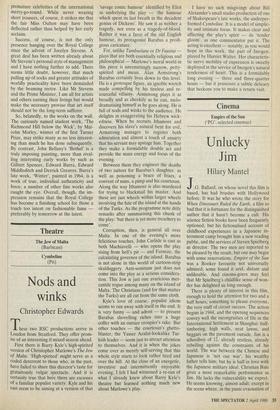ARTS
Exhibitions
College crew
Giles Auty
Exhibition Road: Painters from the Royal College of Art (Royal College Galleries, till 24 April)
Anumber of times occur in a London- based art journalist's year when it is all quiet on the West End front, but the past three months have not been of that nature. Major exhibitions have followed each other so closely that space has been hard to David Hockney's student work, lin in the Mood for Love', 1962
find for earlier mention of the major show of painting arranged, in its refurbished galleries, to mark the 150th anniversary of the Royal College of Art. Over 100 artists who attended the college during this cen- tury are represented by contrasting student and mature works. Which painting is which is obvious in most, if not all cases.
For the past 30 years at least the college has taken on a character which an artist friend of mine compares rather cuttingly to that of a florist's shop. We see the hot- house blooms in the window but are not reminded necessarily of the valuable cul- tivation which has taken place already in less famous art schools. The Royal College is inclined to claim exclusive credit for those of its artists or group movements which have subsequently become house- hold names: Bratby, Smith and Kitchen Sink; Bridget Riley and Op; Hockney, Jones, Blake, Kitaj, Caulfield and Pop.
During the past 30-odd years, the three Professors of Painting at the Royal College have been Carel Weight, Peter de Francia and Paul Huxley, three entirely different personalities and artists. Would it be fair, therefore, to speak of the college as having any particular image during some or all of this period? Was it or is it discernibly different in character from other major post-graduate art schools in London: the Royal Academy Schools, for example, or the Slade? During the Sixties the Slade continued to enrol and develop observant, perceptual artists, a tradition echoed in a quieter vein until recently, at least, by the Royal Academy Schools. The character of the Slade changed sooner and more com- pletely to one of avant-garde emphasis but each post-graduate school certainly boasted, at one time, a distinct personality of its own.
I believe such differences of character are being eroded now to the detriment of the variety of educational experience avail- able. Such choice was a traditional strength of the British system. Perhaps in a period encouraging every kind of artistic freedom, it is worth reminding ourselves that the Slade, under the reputedly oppressive pro- fessorship of Tonks, gave birth to a galaxy of highly distinctive talents. In the cata- logue for the current David Bomberg exhibition at the Tate, Richard Cork writes: `Bomberg benefited from the emphasis laid on the firm underlying struc- ture of draughtsmanship by both Tonks and his fellow professor Fred Brown.' David Bomberg's immediate generation included Gertler, Paul Nash, Nevinson, Roberts, Stanley Spencer and Wadsworth, to mention only a few. Does the Royal College or the Slade hope realistically to produce a crop of similar calibre now or in the immediate future? If the answer is no, why is this the case?
. I feel the spectre of fashionable success hangs too large now over the Royal Col- lege. The examples of Hockney et al who were dragged, unprotesting, into the bosom of commercial success while still in their artistic short trousers, remain too pervasive for current students' well-being. Therese Oulton is merely one of the latest
premature celebrities of the international merry-go-round. While never wearing short trousers, of course, it strikes me that the fair Miss Oulton may have been deflected rather than helped by her early acclaim.
Success, of course, is not the only presence hanging over the Royal College since the advent of Jocelyn Stevens. A great deal has been written already about Mr Stevens's personal style of management and I have nothing further to add. There seems little doubt, however, that much pulling up of socks and greater attitudes of worldly practicality have been demanded by the beaming rector. Like Mr Stevens and the Prime Minister, I am all for artists and others earning their livings but would make the necessary proviso that art itself should not be the long-term sufferer.
So, belatedly, to the works on the wall. The curiously named student work, 'The Richmond Hill below the Wick', by Mal- colm Morley, winner of the first Turner Prize, may strike many as no less interest- ing than much he has done subsequently. By contrast, John Bellany's 'Bethel' is a truly imposing painting, more than rival- ling interesting early works by such as Gilbert Spencer, Edward Burra, Edward Middleditch and Derrick Greaves. Burra's late work, 'Winter', painted in 1964, is a work of true, individual authenticity and force; a number of other fine works also caught the eye. Overall, though, the im- pression remains that the Royal College has become a finishing school for those a touch too intent on fashionable fame preferably by tomorrow at the latest.



















































 Previous page
Previous page